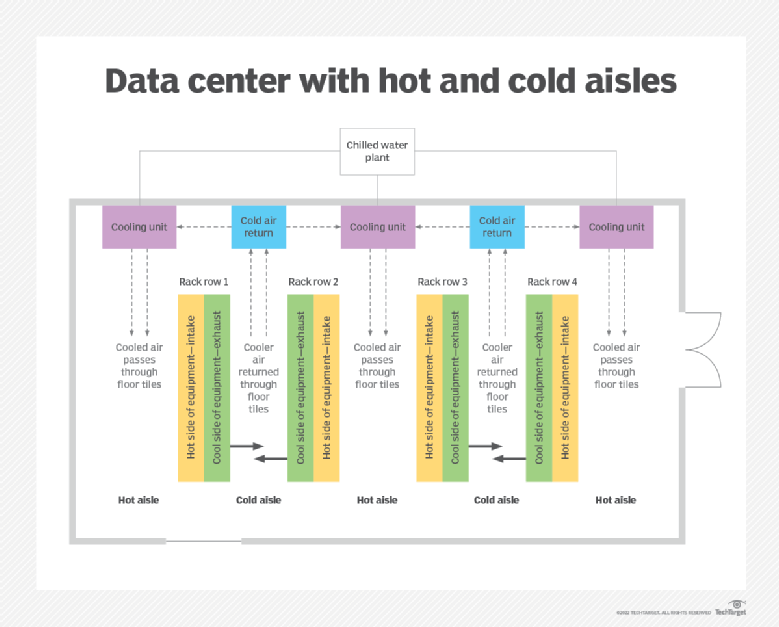Data centers are crucial in modern companies for providing scalable, reliable, and secure access to data and IT resources. However, building data centers requires a significant amount of time and money. So you can not afford mistakes in your data centre design. In this blog, you will learn about the things to consider while creating a data center.
Contents
Building and Infrastructure
The two components of a data center are the building where you will build your data center and the infrastructure you use to make it. Both of these components must be able to fulfill all your business requirements. Therefore, you need to consider the following for the building and infrastructure of your database design.

Building
- You must ensure that the building has enough floor space and is within your requirement. The requirements must also consider future installations. Having enough room will not meet your business goal; having too large an area will be a good use of capital.
- The building must be in a place where you can access it easily. Also, consider the tax at the location; it must be affordable.
- The power supply is another crucial factor. You must have a stable and reliable power supply. You also must have another power supply from renewable resources.
- The data centre design must consider the physical security of the place. For example, the plan must include the placement of verification methods like ID or Biometric scanners and the location of the servers inside the buildings.
- It would help if you designed the data center considering the ability of the building to support the heavy weight of the equipment.
- A data center handles many network traffic and processes that generate heat. So cooling is essential for a data center for smooth operation and to avoid damages due to overheating.
Infrastructure
Infrastructure forms the core of a data center. It includes all the equipment that provides services to customers, employees, and business partners. When designing a data center, you are planning the infrastructure. These include:
- Servers for providing computing functions
- Storage which includes disks for storing information that your service in the data center
- Data network components include routers, hubs, etc., that help connect the data center to the internet
- Backup power provides a supply when the main power supply fails.
- Cable management is necessary for proper airflow
- Racks that provide a platform for all the components mentioned above
- Software that monitors the data center’s health and operation
Data Center Standards
To ensure optimum attention to buildings and infrastructure, companies must follow standards issued by specific organizations. These standards clarify how you should proceed with the building’s conceptual data centre design, layout, construction requirements, physical security, operations, and maintenance. A few standards are:
- Uptime Tier Institute Standard for data centre design, construction, and commissioning
- ANSI/TIA 942-B for planning, design, construction, fire protection, IT, and maintenance
- EN 5600 Series for IT cable, data network design, infrastructure redundancy, and reliability
- ASHRAE guidelines for heating, ventilation, air-conditioning, etc., for buildings
Best practices for designing a data center
Here are some ways you can ensure your data center performs optimally:
- Ensure you measure your data center’s power efficiency using the PUE ratio. This ratio divides the Power the IT infrastructure uses by the Power entering the data center. It will tell you the amount of electricity used by non-IT resources like lightning and FANs.
- To reduce the power consumed by the HVAC equipment, ensure proper airflow. For example, you can use hot and cold aisles for efficiently placing the equipment and cover unused openings so that cool air won’t get wasted. But the power consumed by IT infrastructure increases with cold atmospheres, as it needs to work to bring the equipment to operating temperatures. Therefore, you must maintain your data center at the appropriate temperature. Consider alternative cooling that can reduce the use of HVAC, for example, free-coolers, economizers, etc. These can further reduce HVAC energy consumption.

Source: Hot and Cold Aisles
What not to do while designing a data center?
- While designing a data center, thoroughly assess your infrastructure because poor assessments can increase the cost or may not fulfill your goals.
- Always be careful while calculating the total cost of ownership. Wrong figures may either cause unnecessary spending or panic.
- Take time to decide on the project leader, data center location, or equipment. These are crucial factors that significantly impact your data center’s success.
- Finally, always have the big picture in your mind. This will allow you to access the timeline and remind you to check the completed design before starting the implementation.
Characteristics of a perfect data center
The features of a data center might be unique to your company. However, usually, high-performing data centers have the following features:
- The data center should be scalable as it can remain operational for years; hence, it must scale according to the company’s growth. You must have room for future equipment without compromising the cooling.
- Your data center must be flexible to accommodate new technologies. The data center market is rapidly growing; it might grow to USD 517 Billion by 2030. A flexible data center can avoid time-consuming and costly redesign.
- Disasters can strike anytime, a cyber-attack or a natural calamity. Your data center must be resilient enough to bounce back from these disasters. Moreover, even small power and data network disruptions can cause immense losses. So reliance is an essential characteristic of a thriving data center.
Future of data centers
The projected market value by 2030 is around $500 billion, and the primary driver of this growth is the shift of companies from on-premise data centers to multi-cloud-based data centers. Moreover, public cloud-based data centers are also becoming popular. However, there are challenges to the growth, including privacy concerns and the demand for managed services. Therefore, designing data centers to ensure scalability, sustainability, resilience, and optimum power usage can help you survive market changes. In conclusion, data centers handle vast amounts of information and perform high-capacity processing, generating a large amount of heat. Therefore, you must consider several crucial points while designing a data center, including location, cooling, airflow, and space. In addition, you must consider the data center’s security. This includes both physical and cyber security. For example, your design must consist of access points to buildings, and server locations must be optimized according to security principles. And you may need to have devised-based firewalls and data network monitoring systems. You must consider these points while creating a data centre design.














